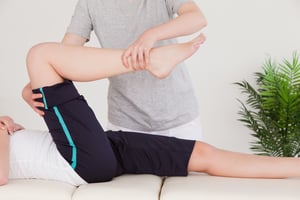When you workout your muscle tissues endure microtrauma, followed by rebuilding of the tissue to make them stronger. So why is it that we hesitate to move after injury?
…The common thought process is that if there is pain, rest is the best option. Unfortunately, this is often not the case.
Let us explore the science:
As previously mentioned, through movement we create microtrauma in the muscles which allows them to repair themselves and become stronger. As we become stronger, tasks that were once difficult and painful become easier. In cases of chronic injuries when there is scar tissue, stressing the tissues is the best way to encourage the tissues to heal as close to the original as possible.
Furthermore, “exercise is a beneficial tool for chronic pain management either on its own or in conjunction with pharmacological interventions” (Ambrose & Golightly 2015). As Accredited Exercise Physiologist, Alex Lawrence explains it, “increased heart rate during exercise, means more blood pumping around your body. More blood flow to the brain causes increased alertness and reduced pain signaling”. While the pain signaling pathways and how exercise modifies them are not fully understood, there is good evidence to suggest that exercise can reduce pain. While this may be true, exercise does not reduce pain in all cases and for all individuals, which is why it is important to have a program tailored to your specific needs to maximize the benefit.
Unlike pharmacological interventions, exercise has the benefit of reducing pain AND increasing physical functioning and overall health. Additionally, in improving overall health there is the added benefit of preventing secondary ailments which may increase pain and decrease quality of life. Research has suggested that exercise can help improve function for a variety of conditions. Centers for Disease Control and Prevention (CDC) notes that exercise can help reduce pain and improve overall quality of life in adults living with arthritis.
Additionally, in improving overall health there is the added benefit of preventing secondary ailments which may increase pain and decrease quality of life. Research has suggested that exercise can help improve function for a variety of conditions. Centers for Disease Control and Prevention (CDC) notes that exercise can help reduce pain and improve overall quality of life in adults living with arthritis.
Applying The Science to REAL People
So, the science support’s exercise for pain modulation and overall healing, but how does it compare to reality?
To illustrate the point, I wanted to share a success story from one of our client’s. They came to us after being diagnosed with Rheumatoid Arthritis (RA)and osteoarthritis in various joints. Prior to coming to us, she had tried working out on her own and with a personal trainer at a gym. However, it was making her worse. As RA is an autoimmune condition it is imperative to combine exercise with appropriate recovery strategies as the body is not able to recover the same way an average person would. Through our signature combination therapy, we were able to successfully reduce pain and inflammation in their joints and improve their overall function. She still gets stiff, but by the end of our workouts she always feels better and has a normal recovery pattern two days later! In addition, she has been able to loose weight, gain strength and improve overall health.
 Another example is with my own experience with injury. I have been dealing with chronic ‘golfers’ elbow’ for the past several months. Even with frequent soft tissue, ultrasound, electrical stimulation and rest, nothing improved my condition. It was only when I started to seriously commit to my rehabilitation program that I started to see decreased pain, and increased functionality. Of course, there are still days where exercise may cause a flare up, but overall, I have seen tremendous growth through rehabilitative exercises.
Another example is with my own experience with injury. I have been dealing with chronic ‘golfers’ elbow’ for the past several months. Even with frequent soft tissue, ultrasound, electrical stimulation and rest, nothing improved my condition. It was only when I started to seriously commit to my rehabilitation program that I started to see decreased pain, and increased functionality. Of course, there are still days where exercise may cause a flare up, but overall, I have seen tremendous growth through rehabilitative exercises.
How Do you Get Started?
Firstly, it is important to go into any program with the knowledge that symptoms may increase at first. This does not necessarily mean we should not move but may indicate that our choices of movements weren’t right for that moment.
So how do you know what the ‘right’ exercises are?
Top tips:
- Consult a movement specialist, such as a Kinesiologist
- The human body is extraordinarily complex, and without an extensive background in human kinetics, you may not be equipped to select the right movements at the right time in your healing journey. No two bodies are the same, and especially when you are dealing with a chronic condition having an approach tailored specifically to your needs is imperative.

- Start small and build it up.
- Isometrics are a great starting point in most cases!
- Let pain and symptoms guide your progressions/regressions
- When in doubt get help: Our team at BODiWORKS is happy to assist you!
Caveats:
There will always be exceptions to the rule, however, overall exercise has proven to be beneficial for pain management, healing, and overall health. In cases such as a broken bone or dislocation you may be limited in how much you can move at first, which should be informed by your doctor or other health care practitioners. However, there is almost always SOMETHING you can do. For example, if you break your leg, we can work on upper body strength and maintain cardiovascular fitness to encourage healing in the leg and overall health.
The bottom line is our bodies are made to move, and here at BODiWORKS we know how to help you optimize your movements, improve your health, and decrease your pain.
Remember Exercise is medicine, even when you are in pain!
